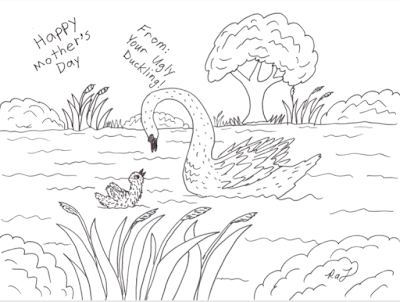Today I am featuring some new and a bit simpler drawings of dinosaurs from the Cretaceous Period. There were three periods in the Mesozoic Era. The first was the Triassic Period, then the Jurassic Period, and finally the Cretaceous Period. It is funny but if you know your dinosaurs you might notice that most of the dinosaurs in Jurassic Park were from the Cretaceous Period, NOT the Jurassic Period. Most of these drawings were started, and done with less detail, for my young grandchildren. So these drawings are not as realistic as some of my dino drawings because they were done for small children.
Parosaurolophus feeding at the Watering Hole
Parasaurolophus was a Hadrosuar or a duck-billed dinosaur. I was taught as a kid that they lived in the water like ducks. Newer theories say they were land animals who even possibly migrated. They probably could swim so maybe they DID like hanging around the watering hole. An adult male could grow up to 36 feet long and wiegh up to 8,000 lbs. That is 11 meters long and a mass of
3629 kg.
T. rex named Scotty
Scotty was a Tyrannosaurus rex or T. rex found in Saskatewan Canada. It is quite possibly bigger than Sue. . . the T. rex found in South Dakota. Scotty may have weighed up to 19,555 lbs. That is 8,870 kg. You may wonder at the protofeathers seen in this drawing. One of the Paleontologists at the University of Utah told me that he thinks it is only a matter of time before we find evidence of feathers on a T. rex. The argument sometimes is made that big animals have a hard time getting rid of heat so maybe only the chicks had the downy feathers to keep warm. Then as they grew they lost most or all of their feathers. The Cretaceous was a warm time in the history of the Earth. The polar ice caps did not exist so therefore the ocean levels were higher. A stretch of ocean separated the western part of North America (where T. rex lived) from eastern North America. So a great deal of the midwest was under water back then. By the way, Scotty was named after the scotch they drank to celebrate the find of the fossils. T. rex had crushing teeth so it probably ate pretty much all the prey, like modern hyenas.
Mapusaurus with Young
Mapusaurus was a large Theropod or carnivorous dino from South America. It probably fed by taking bites our of the legs and sides of Argentinosaurus and Patagotitan. Mapusaurus had slicing teeth. Notice the Argentinosaurs in the background. The Titanosaurs were the biggest land animals ever to walk the Earth. Some may have been 127 feet or 37 meters long and weighed up to 76 tons or 69 metric tonnes. In comparison Mapusaurus was around 44 feet or 14.4 meters long and weighed somewhere around 4000 lbs or 2 tons. It is thought that Mapusaurus hunted in packs. Mapusaurs actually may have been longer than T. rex but it was more lightly built. T. rex is probably the heaviest land predator to ever live, if you consider that Spinosaurus probably hunted primarily for fish.
Triceratops with Two Calves
Triceratops is my favorite dinosaur. It was a herbivore that had horns as long as broom handles. It has been hypothesized by John Horner that the horns only pointed forward when the animal was fully mature. The frill or shield stretched back over the back and neck of the young Triceratops. This was for protection from predators. Of course a T. rex could eat a baby Triceratopos in one bite, but there were smaller predators back then too. Triceratops was the last and largest of all Ceratopsian Dinosaurs. A full grown bull was 30 feet long and up to 26,000 lbs.
Ankylosaurus feeding on Ferns
Ankylosaurus was the huge armored dinosaur that was built like an armored tank. It had very thick probably dermal armor. It was so welled armed that even its eylids were armed. If you tried to shoot through the armor the bullet probably would not penetrate to the internal organs. Aknylosaurs probably hunkered down and swung its club tail when a T. rex came to call. Ankylosaurs weighed up to 15,000 lbs and was up to 35 feet long. That is 6,804 kg and 10.7 kg. This Ankylosaur is hunkered down in a defensive posture. . . maybe he smelled a T. rex in the area. I will admit that this drawing is more of the old school idea that put dinosaurs as less active. I should have drawn the legs longer and the tail a little thinner. But old habits die hard sometimes.
Printable versions of these new drawings are found by clicking on the buttons up top. Click on either All Printables or Paleontology.
















































